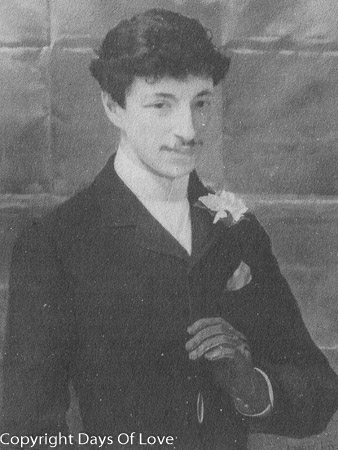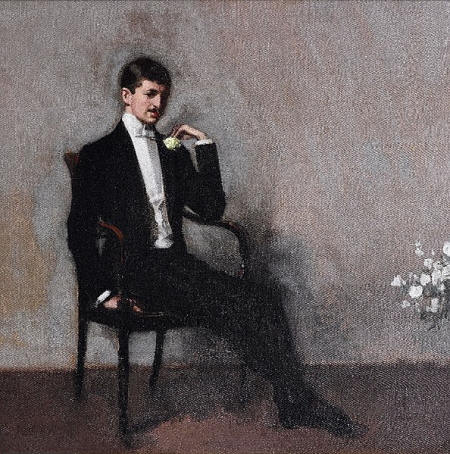 Marc-André Raffalovich[1] (11 September 1864 – 14 February 1934) was a French poet and writer on homosexuality, best known today for his patronage of the arts and for his lifelong relationship with the poet
John Gray.
Marc-André Raffalovich used a female persona for some of his early poems,
Cyril and Lionel (1884), which allowed him to be quite explicit. In 1894
lovers John Gray and Marc-Andre Raffalovich
produced a play called The Blackmailers. Rose Leaves When the Rose is Dead (1886), The World Well Lost IV (1886), The World Well Lost XVIII (1886), Lovelace (1886), Put on that Languor (1889) and Tulip of the Twilight (1895) are cited as examples in Sexual Heretics: Male Homosexuality
in English Literature from 1850-1900, by Brian Reade.
Marc-André Raffalovich[1] (11 September 1864 – 14 February 1934) was a French poet and writer on homosexuality, best known today for his patronage of the arts and for his lifelong relationship with the poet
John Gray.
Marc-André Raffalovich used a female persona for some of his early poems,
Cyril and Lionel (1884), which allowed him to be quite explicit. In 1894
lovers John Gray and Marc-Andre Raffalovich
produced a play called The Blackmailers. Rose Leaves When the Rose is Dead (1886), The World Well Lost IV (1886), The World Well Lost XVIII (1886), Lovelace (1886), Put on that Languor (1889) and Tulip of the Twilight (1895) are cited as examples in Sexual Heretics: Male Homosexuality
in English Literature from 1850-1900, by Brian Reade.Raffalovich was born into a wealthy Jewish family, which moved from Odessa to the French capital, Paris, in 1863. His brother, Arthur, became a noted Parisian financier and economist. André went up to study in Oxford in 1882 before settling down in London and opening a salon in the 1890s. Oscar Wilde attended, calling the event a saloon rather than a salon.[2] This is where Raffalovich met the love and companion of his life, John Gray. In 1890, his sister Sophie married the Irish nationalist politician William O'Brien (1852–1928).
In 1894, Raffalovich started to contribute on the subject of homosexuality (''unisexualité'', as he called it) to the ''Archives de l'Anthropologie Criminelle'', a prestigious revue founded in Lyon by Alexandre Lacassagne, a pioneer criminologist and professor of forensic medicine. He soon became recognised as an expert in the field, engaging in correspondence with other researchers throughout Europe.
His magnum opus, ''Uranisme et unisexualité: étude sur différentes manifestations de l'instinct sexuel'' was published in 1896. In 1897, he started working on ''Annales de l'unisexualité'', and ''les Chroniques de l'unisexualité'' with the aim of cataloguing everything published on the subject of homosexuality. These have proved useful to historians up to this day.

Marc-André Raggalovich by Sydney Starr
In 1896, under the influence of John Gray, Raffalovich embraced Catholicism and joined the tertiary order of the Dominicans as Brother Sebastian in honour of Saint Sebastian. At the same time Gray was ordained a priest. In 1905, Gray was appointed to the parish of St Patrick in the working class Cowgate area of Edinburgh. Raffalovich followed and settled down nearby, purchasing No. 9, Whitehouse Terrace. He contributed greatly to the cost of St Peter's Church in Morningside, Edinburgh, of which Gray was appointed the first parish priest. In Whitehouse Terrace, Raffalovich established a successful salon. His guests included Henry James, Lady Margaret Sackville, Compton Mackenzie,[3] Max Beerbohm and Herbert Read.
There is a close link between Raffalovich's views on homosexuality and his Catholic beliefs. In contrast to then-current theories of sexual inversion, according to which a man was gay because he had a female soul in a male body and a woman was lesbian because she had a male soul in a female body, and which thus essentially reproduced heterosexuality, Raffalovich's view of "unisexuality" held that it consisted of attraction to the ''same'' sex, closer to the modern conception of homosexuality. He wrote of gay men, "As men, they love men; but they affirm that were they women they would love women."[4] He made the distinction between the born and the chosen inverts. He believed the former worth considering while the latter he thought to be mired in vice and perversion.
Raffalovich drew, however, a difference with heterosexuality based on the idea of vice and virtue. He regarded a heterosexual's destiny as marriage and starting a family, whereas a homosexual's duty, he believed, was to overcome and transcend his desires with artistic pursuits and spiritual – even mystical – friendships.
These views led him to clash with Magnus Hirschfeld and the members of the Scientific Humanitarian Committee, with Raffalovich accusing them of being propagandists for moral dissolution and of wanting to destroy whole generations. He even supported Germany's Paragraph 175 as a way to prevent total moral chaos.
Raffalovich's attempts to reconcile his homosexuality and his Catholic beliefs pushed him further into his criticism of the early gay liberation movement; in 1910, he finally stopped commenting altogether on the subject which had occupied such a place in his life. Instead, he focused on his Edinburgh salon and his support of young artists.
He died in 1934, the same year as his lifelong companion, John Gray.

